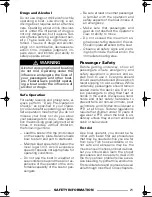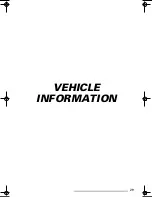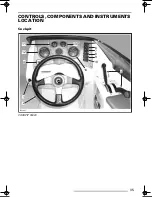
24
SAFETY INFORMATION
– Always carry an observer when pull-
ing a tube, skier or wakeboarder,
proceed with only as much speed
as required and follow the observ-
er's instructions. Unless absolutely
necessary, do not make tight, sharp
turns. Keep a safe distance from the
docks, other swimmers, craft or ob-
jects.
– Use a tow rope of sufficient length
and size and make sure it is ade-
quately secured to your boat. Some
boats are equipped or can be fitted
with a specially designed towing
mechanism. It can become a hazard
should someone fall on it.
Don’t Forget:
– Ride smart from the start and we all
win!
Voluntary Inspections
State boating officials in many states or
the U.S. Coast Guard Auxiliaries offer
courtesy inspections to check out your
boat. They will check for compliance
with safety standards and required
safety equipment. You may voluntarily
consent to one of these inspections,
and you are allowed time to make cor-
rections without prosecution. Check
with the appropriate state agency or
the Coast Guard Auxiliary for details.
Safe Boating Courses
The local U.S. Coast Guard Auxiliary and
the U.S. Power Squadrons offer com-
prehensive safe boating classes several
times a year. You may contact the
BOAT/U.S. Foundation at 1 800 336-
BOAT (2628) or, in Virginia, 1 800 245-
BOAT (2628), for a course schedule in
your area. Also contact the local U.S.
Coast Guard Auxiliary or Power Squad-
ron Flotilla for the time and place of their
next scheduled class. A boating safety
course is recommended and may be re-
quired in your province or state.
Water Sports
Water skiing, wakeboarding, or riding
a towed, inflatable apparatus are some
of the more popular water sports. Tak-
ing part in any water sport requires in-
creased safety awareness by the par-
ticipant and the boat operator. If you
have never pulled someone behind
your boat before, it is a good idea to
spend some hours as an observer,
working with and learning from an ex-
perienced driver. It is also important to
be aware of the skill and experience of
the person being pulled. Always have
a second person on board to observe
the person in the water so the driver
can concentrate on operating the boat.
Both the boat operator and observer
should monitor the location of the tow-
rope when participating in water-
sports. A slack tow rope can become
entangled with person(s) or objects in
the boat or in the water, particularly
when making a tight turn or circling,
and cause serious personal injury.
WARNING
Avoid Personal Injury!
Your boat is
not designed for and should not
be used for pulling parasails, kites,
gliders, or any device which can
become airborne. Use boat only
for appropriate water sports.
WARNING
“Teak Surfing”
is extremely dan-
gerous to participants due to their
proximity to the rear of the boat
where direct contact with the ex-
haust fumes from the boat engine
is the highest. Carbon monoxide
poisoning can occur and result in
mental disorientation, dizziness,
d r ow sin ess, a nd lo ss of co n-
sciousness. The combination of
carbon monoxide exposure and
non-use of a life jacket (PFD) make
this new water recreation activity
an incredibly dangerous and po-
tentially deadly sport.
lmo2005-007a_1.book Page 24 Wednesday, September 1, 2004 3:27 PM
Содержание Challenger*180
Страница 1: ......
Страница 10: ...SAFETY INFORMATION 9 SAFETY INFORMATION ...
Страница 29: ...29 VEHICLE INFORMATION ...
Страница 35: ...35 CONTROLS COMPONENTS AND INSTRUMENTS LOCATION Cockpit COCKPIT VIEW F23L03L 11 12 4 13 5 6 7 8 9 10 14 3 1 2 ...
Страница 77: ...77 MAINTENANCE INFORMATION ...
Страница 99: ...99 WARRANTY INFORMATION ...
Страница 130: ......
















































